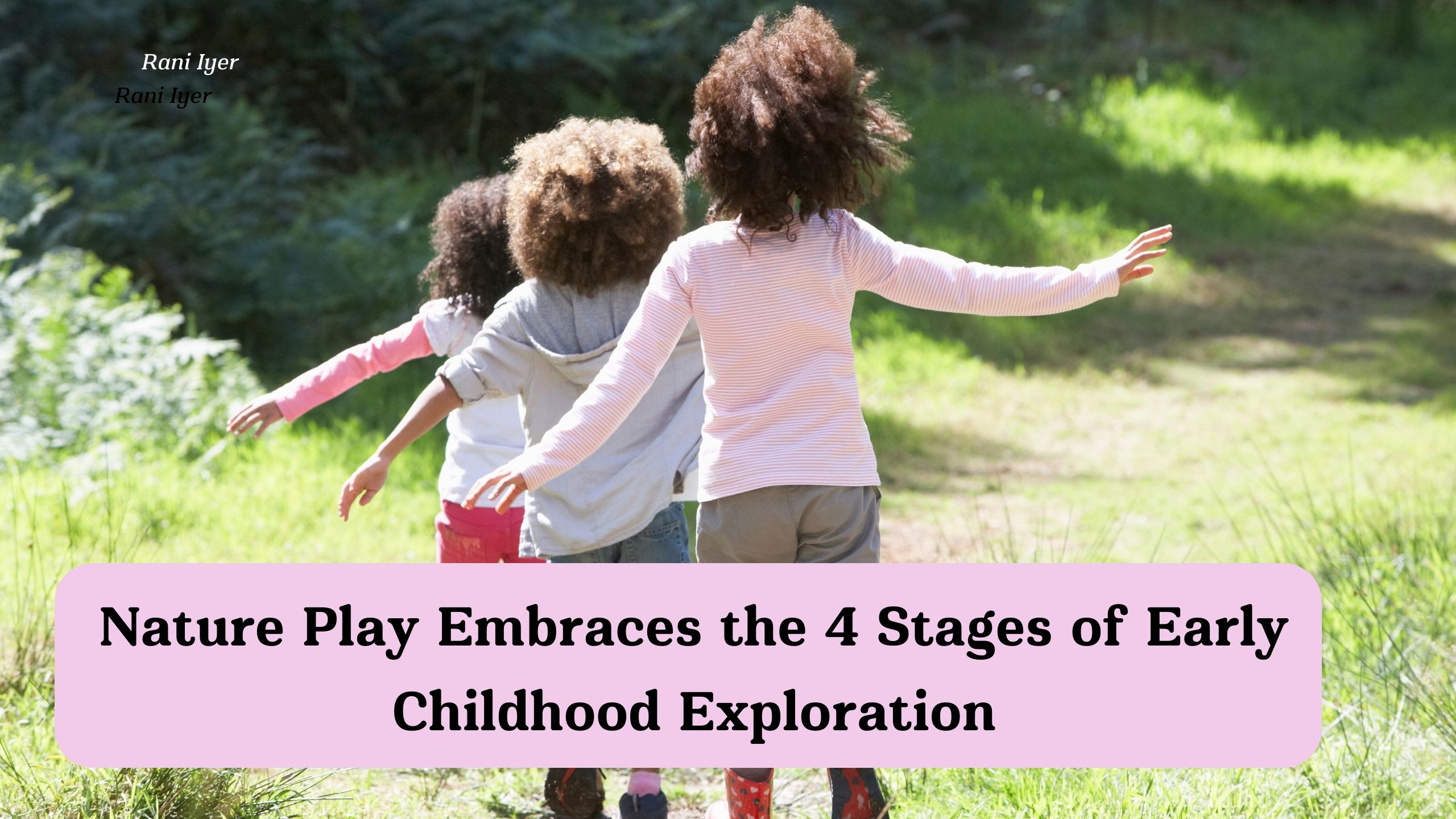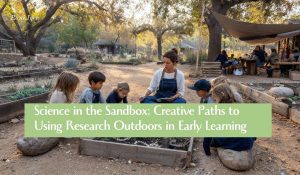In the journey of early childhood, there are four stages of exploration that are instrumental in shaping a child’s development. And in this digital age, where screens dominate our lives, it is crucial to remember the power of nature in nurturing play.
In this article, we delve into how nature embraces these four stages of early childhood exploration – from sensory experiences to imaginative play and everything in between. We explore the ways in which outdoor environments provide the ideal setting for children to engage their senses, build positive relationships, develop creativity, and enhance their cognitive abilities.
From climbing trees and splashing in puddles to digging in the dirt and spotting insects, nature offers a myriad of opportunities for young children to learn and grow. We’ll uncover the science behind how nature contributes to brain development, emotional well-being, and overall health.
So, join us as we dive into the world of nature and discover how it plays a vital role in nurturing the four stages of early childhood exploration. Prepare to be amazed by the wonders that await when we let children connect with the great outdoors.
The four stages of early childhood exploration
As children grow and develop, they go through distinct stages of play and exploration. These four stages are crucial in shaping a child’s cognitive, social, and emotional development. By understanding and nurturing these stages, we can create an environment that fosters learning, creativity, and healthy relationships.
1: Solitary play – alone (~2-2 ½ years)
During the first stage of early childhood exploration, children engage in solitary play, where they explore their environment and toys on their own. This stage is characterized by a child’s desire to manipulate objects, experiment with their senses, and discover the world around them.
In nature, solitary play might involve a child digging in the dirt, splashing in a puddle, or examining the intricate patterns of a leaf. These sensory experiences help children develop a deeper understanding of the physical world and their own capabilities. By allowing children to engage in this uninterrupted exploration, we provide them with the opportunity to build a strong foundation for future learning and development.
Observing children during this stage can provide valuable insights into their interests, problem-solving skills, and the way they process information. As parents and caregivers, we can support this stage of play by creating safe and engaging outdoor environments that encourage independent exploration and discovery.
2: Parallel play – children play alongside each other (~2 ½ to 3 ½ years)
As children move into the second stage of early childhood exploration, they begin to engage in parallel play. During this stage, children play alongside each other, often with similar toys or materials, but they do not necessarily interact or coordinate their play.
In the natural world, parallel play might involve two children building separate sandcastles or collecting different types of leaves. While they may not be actively playing together, they are learning to navigate social situations and develop an awareness of their peers.
This stage is important for fostering social skills, as children begin to observe and mimic each other’s behaviors. By providing opportunities for parallel play in nature, we can help children develop the foundations for more complex social interactions and collaborative play in the future.
3: Associative play – play and share (~3 ½ to 4 1/2)
As children reach the third stage of early childhood exploration, they begin to engage in associative play. During this stage, children start to interact with each other, share materials, and engage in loosely organized activities.
In the natural environment, associative play might involve children working together to build a fort using fallen branches and leaves, or collaborating to create a mud pie kitchen. These shared experiences help children develop communication skills, problem-solving abilities, and a sense of community.
By encouraging associative play in nature, we can foster the development of social and emotional skills, such as empathy, conflict resolution, and the ability to share and take turns. These skills are crucial for children as they navigate the complexities of social interactions and prepare for the next stage of play.
4: Cooperative play – defined division of labour and shared purpose (~4 ½ and up)
The fourth and final stage of early childhood exploration is cooperative play. During this stage, children engage in organized, goal-oriented activities that require a defined division of labor and a shared purpose.
In the natural world, cooperative play might involve children working together to construct a tree house, plan and execute a scavenger hunt, or organize a nature-themed performance. These activities require children to communicate effectively, delegate tasks, and coordinate their efforts to achieve a common goal.
By fostering cooperative play in nature, we can help children develop essential skills, such as leadership, decision-making, and the ability to work collaboratively. These skills not only benefit children in their immediate play experiences but also lay the foundation for future academic, social, and professional success.
Benefits of nurturing play in each stage of early childhood
The four stages of early childhood exploration are not just about play; they are essential components of a child’s overall development. By nurturing play in each stage, we can unlock a wealth of benefits that support children’s physical, cognitive, social, and emotional well-being.
Sensory exploration and brain development
During the solitary play stage, children’s engagement with the natural world through their senses – touch, sight, sound, smell, and taste – stimulates the development of neural pathways in the brain. This sensory exploration helps children better understand their environment, build problem-solving skills, and lay the groundwork for more complex learning.
As children progress through the parallel and associative play stages, their interactions with nature continue to support brain development. The diverse textures, colors, and sounds found in the natural world challenge children’s cognitive abilities, encouraging them to explore, experiment, and make connections.
In the cooperative play stage, children’s engagement with nature becomes more intentional and goal oriented. This level of cognitive engagement further strengthens the neural connections in the brain, preparing children for more advanced problem-solving, critical thinking, and decision-making skills.
Emotional regulation and positive relationships
The natural world provides a calming and restorative environment that can help children regulate their emotions and develop positive relationships. During the solitary play stage, children can find solace and comfort in the tranquility of nature, allowing them to process their feelings and develop self-awareness.
As children move into the parallel and associative play stages, their interactions with peers in the natural setting can foster empathy, cooperation, and the ability to navigate social situations. The shared experiences and the sense of community that emerges from nature-based play can help children build strong, supportive relationships.
In the cooperative play stage, children’s collaborative efforts in nature can instill a sense of accomplishment, pride, and belonging. These positive emotions and social connections contribute to children’s overall emotional well-being and resilience.
Physical development and health
The natural environment provides ample opportunities for physical activity and gross motor development. During the solitary play stage, children can engage in activities like climbing, balancing, and running, which strengthen their muscles, coordination, and overall physical fitness.
As children progress through the parallel and associative play stages, their physical interactions with nature become more complex. They may engage in activities like jumping over logs, navigating uneven terrain, or chasing each other through the woods, further enhancing their physical capabilities and promoting healthy habits.
In the cooperative play stage, children’s physical engagement with nature can take on a more organized and strategic form, such as building structures, creating obstacle courses, or engaging in team-based games. These activities not only support physical development but also foster a sense of accomplishment and the ability to work collaboratively towards a common goal.
Resources and activities for fostering nurturing play in nature
Playing in nature is a powerful tool for supporting the four stages of early childhood exploration. By providing a diverse range of resources and engaging activities, we can create enriching outdoor experiences that foster children’s learning, development, and overall well-being.
Exploration
To encourage sensory exploration during the solitary play stage, consider offering a variety of natural materials, such as leaves, sticks, stones, sand, and water. Encourage children to touch, smell, and observe these elements, allowing them to engage their senses and make discoveries about the world around them.
Provide opportunities for children to explore the textures of bark, the scent of flowers, the sound of rustling leaves, or the taste of edible plants. These sensory experiences will not only stimulate their curiosity but also support the development of their cognitive and language skills.
As children progress through the parallel and associative play stages, expand their sensory exploration by introducing more complex natural elements, such as mud pits, climbing structures, or small creatures like insects or lizards. Encourage children to observe, interact, and document their findings, fostering their scientific inquiry and problem-solving abilities.
Imaginative and cooperative play
To nurture imaginative and cooperative play in nature, create opportunities for children to engage in open-ended, creative activities. During the parallel and associative play stages, provide materials like sticks, leaves, and stones that can be used to build forts, design mud kitchens, or create nature-inspired art.
Encourage children to work together to plan and execute these projects, allowing them to develop communication, negotiation, and teamwork skills. Facilitate discussions about their creations, their roles, and the challenges they faced, helping them reflect on the process and build a sense of shared purpose.
As children reach the cooperative play stage, consider organizing nature-based scavenger hunts, treasure maps, or collaborative building challenges. These activities will require children to coordinate their efforts, assign tasks, and work towards a common goal, fostering essential skills for future success.
Outdoor exploration and discovery
To support children’s outdoor exploration and discovery, create a safe and engaging natural environment that encourages curiosity and investigation. During the solitary play stage, set up a designated area with a variety of natural elements, such as logs, rocks, and water features, that children can freely explore.
As children progress through the parallel and associative play stages, expand the outdoor space to include more complex terrain, such as hills, streams, or wooded areas. Encourage children to observe and document the changes in their environment, such as the growth of plants, the movement of animals, or the effects of weather.
In the cooperative play stage, organize nature-based scavenger hunts or guided hikes that challenge children to work together to identify and explore different elements of the natural world. These activities will not only support their cognitive development but also foster a sense of wonder and appreciation for the natural environment.
The four stages of early childhood exploration: physical play
The four stages of early childhood exploration are not just about cognitive and social development; they also have a significant impact on children’s physical well-being. By nurturing play in nature, we can support the physical growth and development of children at each stage.
Stage 1: Solitary play – alone (~2-2 ½ years)
During the solitary play stage, children’s physical exploration in nature can involve activities like crawling, walking, climbing, and balancing. These gross motor skills are essential for developing muscle strength, coordination, and spatial awareness.
By providing a safe and engaging outdoor environment, we can encourage children to challenge themselves physically, build confidence, and develop a love for physical activity. Simple activities like scrambling over logs, navigating uneven terrain, or splashing in shallow water can help children hone their physical abilities and build a strong foundation for future development.
As children engage in these solitary physical play activities, they are also developing their sensory awareness and problem-solving skills, which are crucial for overall cognitive and motor development.
Stage 2: Parallel play – children play alongside each other (~2 ½ to 3 ½ years)
As children move into the parallel play stage, their physical interactions with nature become more complex and social. They may engage in activities like chasing, running, and climbing alongside their peers, developing a greater sense of spatial awareness and coordination.
In the natural environment, children can explore the challenges of navigating obstacles, balancing on uneven surfaces, or negotiating shared spaces with their peers. These physical activities not only support gross motor development but also foster social skills, such as taking turns, sharing resources, and negotiating conflicts.
By encouraging parallel play in nature, we can help children build confidence, improve their physical abilities, and learn to navigate social situations in a safe and nurturing setting.
Stage 3: Associative play – play and share (~3 ½ to 4 1/2)
As children reach the associative play stage, their physical interactions in nature become more collaborative and organized. They may work together to build structures, create obstacle courses, or engage in team-based games and activities.
These physical challenges require children to communicate, problem-solve, and coordinate their efforts, further developing their gross and fine motor skills. Additionally, the sense of accomplishment and teamwork that emerges from these collaborative physical activities can boost children’s self-esteem and foster a positive attitude towards physical activity.
By providing opportunities for associative physical play in nature, we can help children develop a range of skills, including leadership, decision-making, and the ability to work cooperatively towards a common goal.
Stage 4: Cooperative play – defined division of labor and shared purpose (~4 ½ and up)
In the final stage of early childhood exploration, children’s physical play in nature becomes increasingly organized and goal-oriented. They may engage in activities like constructing elaborate forts, designing obstacle courses, or planning and executing nature-themed games and performances.
These cooperative physical activities require children to delegate tasks, communicate effectively, and coordinate their efforts to achieve a shared purpose. This level of physical engagement not only supports the development of gross and fine motor skills but also fosters critical thinking, problem-solving, and the ability to work as part of a team.
By nurturing cooperative physical play in nature, we can help children develop a sense of accomplishment, build leadership skills, and cultivate a lifelong appreciation for physical activity and the great outdoors.
Nurturing play activities for each stage of early childhood exploration
To support the four stages of early childhood exploration, we can engage children in a variety of nature-based play activities that cater to their specific developmental needs and interests. By providing a diverse range of experiences, we can ensure that children have the opportunity to explore, learn, and grow at their own pace.
Stage 1: Solitary play – alone (~2-2 ½ years)
- Sensory exploration: Encourage children to touch, smell, and observe natural elements like leaves, flowers, and stones. Provide opportunities for them to dig in the dirt, splash in puddles, or feel the textures of tree bark.
- Observational play: Set up a nature observation station with magnifying glasses, binoculars, and a nature journal where children can closely examine insects, birds, or other small creatures.
- Imaginative play: Offer natural materials like sticks, leaves, and stones that children can use to create their own imaginary worlds and stories.
Stage 2: Parallel play – children play alongside each other (~2 ½ to 3 ½ years)
- Obstacle courses: Create a nature-inspired obstacle course with logs, rocks, and uneven terrain that children can navigate individually or alongside their peers.
- Nature art: Provide a variety of natural materials, such as leaves, flowers, and twigs, and encourage children to collaborate on creating nature-inspired art pieces.
- Scavenger hunts: Organize a scavenger hunt where children work independently or in pairs to find and collect specific natural items, like different types of leaves or interesting rocks.
Stage 3: Associative play – play and share (~3 ½ to 4 1/2)
- Mud kitchens: Set up a mud kitchen where children can work together to mix, pour, and create imaginative mud-based concoctions.
- Nature builders: Challenge children to work together to construct shelters, forts, or other structures using natural materials like sticks, leaves, and stones.
- Nature performances: Encourage children to collaborate on nature-themed performances, such as a play about the life cycle of a butterfly or a dance inspired by the movements of animals.
Stage 4: Cooperative play – defined division of labor and shared purpose (~4 ½ and up)
- Nature-based challenges: Design cooperative challenges, such as building a tree house or creating an outdoor obstacle course, that require children to work together to plan, delegate tasks, and execute a shared goal.
- Nature expeditions: Organize group hikes or nature walks where children can work together to navigate the terrain, identify plants and animals, and document their findings.
- Outdoor games: Facilitate team-based outdoor games, such as capture the flag or nature-themed scavenger hunts, that encourage children to strategize, communicate, and collaborate.
By offering a diverse range of nature-based play activities that cater to the unique needs and interests of children at each stage of early childhood exploration, we can create a nurturing and enriching environment that supports their overall development and well-being.
Conclusion: Embracing the power of nature in early childhood development
As we’ve explored, the four stages of early childhood exploration – solitary play, parallel play, associative play, and cooperative play – are instrumental in shaping a child’s cognitive, social, emotional, and physical development. And in this digital age, where screens and technology often dominate our lives, it is crucial to remember the power of nature in nurturing these critical stages of growth.
By embracing the natural world and providing children with ample opportunities to engage in sensory exploration, imaginative play, and collaborative activities, we can unlock a wealth of benefits that support their overall well-being. From enhanced brain development and emotional regulation to the promotion of physical health and positive relationships, the great outdoors offers a myriad of opportunities for children to learn, grow, and thrive.
As parents, caregivers, and educators, it is our responsibility to create environments that foster this connection to nature and nurture the four stages of early childhood exploration. By doing so, we can empower children to become curious, resilient, and adaptable individuals who are equipped to navigate the complexities of the world around them.
So, let’s embrace the power of nature and the magic of play, and embark on a journey of discovery that will shape the lives of our youngest learners. Together, we can unlock the full potential of early childhood exploration and pave the way for a future where children flourish, both in the natural world and beyond.




